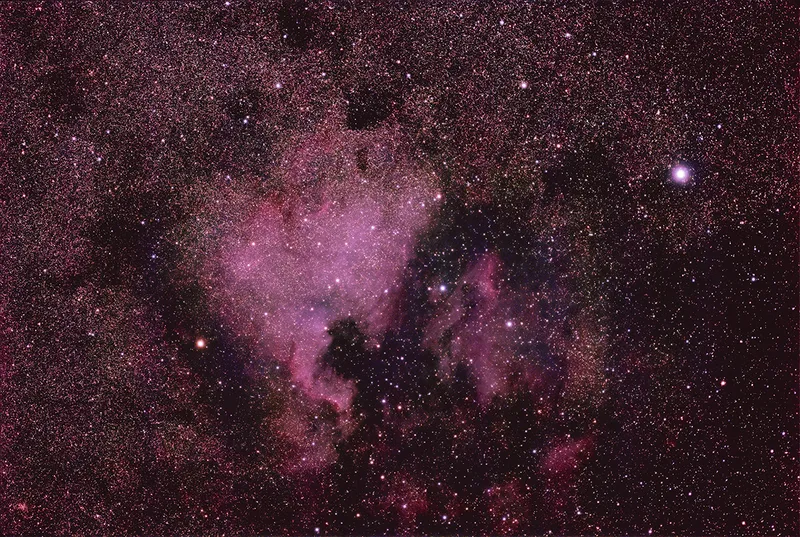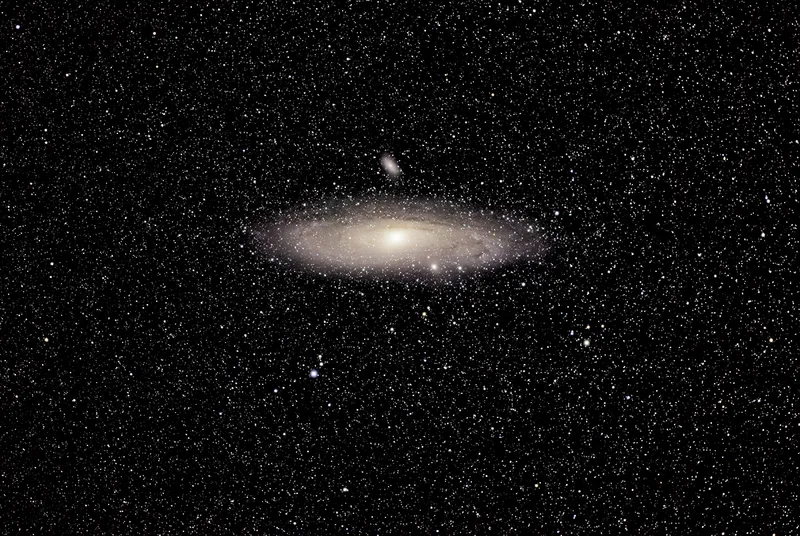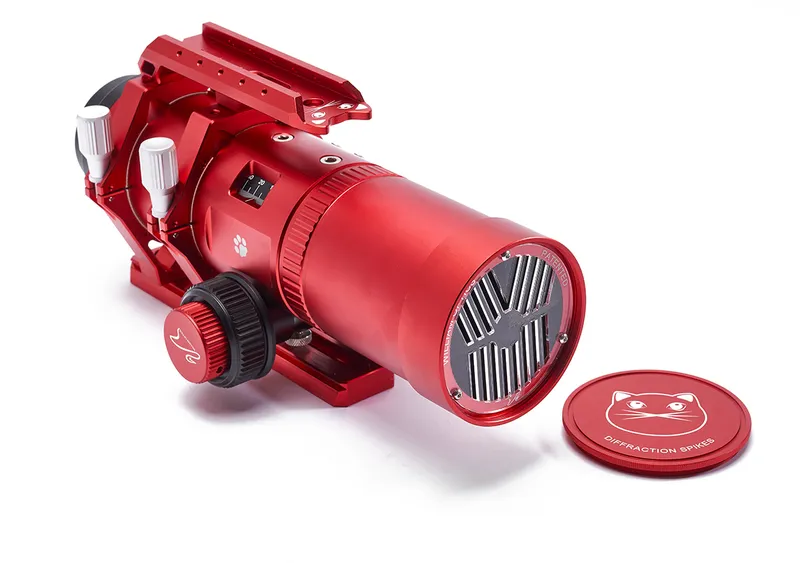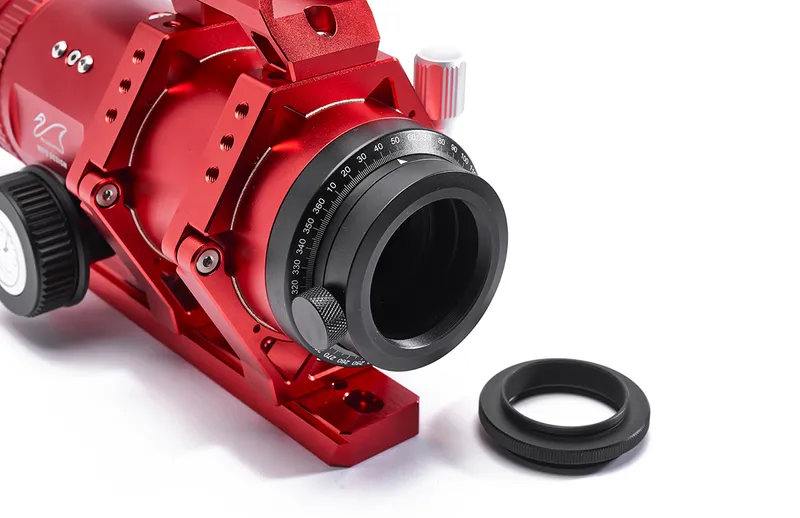William Optics specialises in producing high-quality refractors that push technology and design whenever they can, and the RedCat 61 WIFD is no exception.
It’s aimed at astrophotographers and is finished in a stunning metallic red that really sets it apart.
But it doesn’t just look good, it’s functional and, as we found, does the job very well.
Buy now from Ali Express

It is the mid-sized instrument in the RedCat range, which also includes the RedCat 51 and 71 astrographs – new versions of these have now been released which also feature the WIFD.
The RedCat 61 WIFD has a 61mm-diameter objective lens with the unique Petzval design used in William Optics’s RedCat astrographs, the optical elements featuring FPL-53 glass.
This provides a flat field of view along with excellent colour correction.
The focal length is compact at just 300mm, giving a focal ratio of f/4.9, nice and fast, and ideal for an astrograph – and all this in a tube just 365mm long and weighing little more than a couple of bags of sugar, 2.5kg.
We’ll discuss the internal focuser design separately, but its placement changes the look of the refractor and marks it out from the competition.

Setting up and mounting
The setup includes a dual-speed focus mechanism with a protective screw-on cap for the fine-focus knob, an integrated thermometer on the opposite coarse-focus knob, a dew shield with an integrated Bahtinov mask set in its cap, a hidden tilt mechanism and an M48 camera adaptor at the back.
The RedCat 61 WIFD also comes with tube rings and a Vixen-style dovetail base, which are lighter than standard setups yet still rigid, along with a ‘cat face’ saddle handle bar at the top for attaching a guidescope.
The tube rings also feature screw holes for attaching a finderscope.

Spare screws and a set of hex keys are thoughtfully included. The keys allow adjustment of the focus tensioning and tilt mechanism, and are used to attach the optional ZWO electronic automatic focuser.
You can either mount the astrograph on a Vixen-style mount or on certain portable astro camera tracking mounts via the threaded screw holes under the Vixen bar.
If you go down this route, ensure the mount can take the weight, including that of any camera gear. You may need additional counterweights to achieve balance.
When we mounted the RedCat 61 on our Sky-Watcher AZ-EQ6 mount we did notice the focuser wheels just caught the mount.

Traditionally, the focuser would be at the rear end of the telescope, so being set at the middle may cause you a slight issue.
You can remedy this by either rotating the tube so that the tube assembly is in effect upside down (note this also means the graduated scale is also upside down) or add an additional Vixen bar to the base.
In our case, the setup happened to balance with the focus knobs just overhanging the mount and we had no problem with this arrangement.
Astrophotography verdict

We borrowed the correct adaptor for our Canon R6 mirrorless camera and easily focused using the Bahtinov mask.
We found the wide field of view meant we could easily fit the North America Nebula and Pelican Nebula in the same field of view with space to spare.

On the few clear nights we had we also imaged the Sadr region of Cygnus, and the Andromeda Galaxy and its companions.
Even with high ISO and short exposures of between 10 and 30 seconds we achieved impressive results for all three targets.
We just wish we’d had more clear nights to image the star fields of the Milky Way.
Overall, we were highly impressed with the RedCat 61 WIFD and it would make a fine addition to anyone’s imaging setup. We didn’t want to let it go!

WIFD internal focuser
WIFD stands for William Optics Internal Focus Design.
Instead of placing the focuser at the rear of the tube, in this design the focuser is internal and moves the optical assembly.
Rotating the focuser knob moves the optical setup inside to achieve focus.
It is roughly in the centre of the tube, which also aids in balancing the setup while your camera gear is attached to the rear of the telescope.

This arrangement eliminates potential tilting due to the weight of camera gear that can sometimes occur on traditional focusers.
A window on one side shows a graduated scale so you can note the position of sharpest focus for later sessions.
We found the focusing very smooth, with no slippage.
The focusing mechanism is dual-speed, with coarse- and fine-focus on one side, while the main focuser knob has an integrated thermometer – useful for those with thermoelectric cooling systems on their cameras, so they can adjust them to the ambient temperature setting of the astrograph.

5 best features
Dew shield with Bahtinov mask
The dew shield is fixed in place but provides good protection for the internal lens arrangement. The front dust cap also incorporates a detachable Bahtinov mask for focusing. Unscrew the dust cap to leave the Bahtinov mask in place, then screw back on and slide the cap off to begin imaging.
Camera adjustment, tilt mechanism and camera adaptor
The rear of the system looks odd without a traditional focuser but has several useful functions. There is the rotatable camera adjuster so you can frame your target with ease, an M48 camera adaptor that is threaded to take 2-inch filters, and a hidden tilt adaptor behind the graduated scale.
Optics
The RedCat 61’s optics comprise of a 61mm-objective four-element Petzval design composed of EPL-53 glass to give a pin-sharp, flat field. The result is a 45mm image circle which allows full use of full-frame cameras, be they DSLR, mirrorless, CCD or CMOS.
Tube rings, mounting bar and saddle
The tube mounting rings, Vixen-style mounting bar and upper saddle handle bar are lightweight yet strong and rigid enough to carry the telescope. The tube rings have additional screw holes for adding a finderscope and the saddle bar allows for the firm attachment of a suitable guidescope.
Soft carry case
The RedCat 61 WIFD comes with a stylish, well-padded, soft carry case that protects the telescope when not in use or for travelling. There is also a package of spare screws for affixing a finderscope and a seven-piece hex key set for making adjustments to the telescope.

Key stats
- Price: £1,629
- Optics: Petzval design
- Aperture: 61mm
- Focal length: 300mm, f/4.9
- Tube length: 365mm
- Focuser: Dual-speed WIFD
- Extras: RedCat tube rings, Vixen dovetail bar, saddle handle bar, integrated Bahtinov mask, soft carry case, hex tools
- Weight: 2.5kg
- Supplier: The Widescreen Centre
- Tel: 01353 776199
- www.widescreen-centre.co.uk
This review appeared in the November 2023 issue of BBC Sky at Night Magazine
